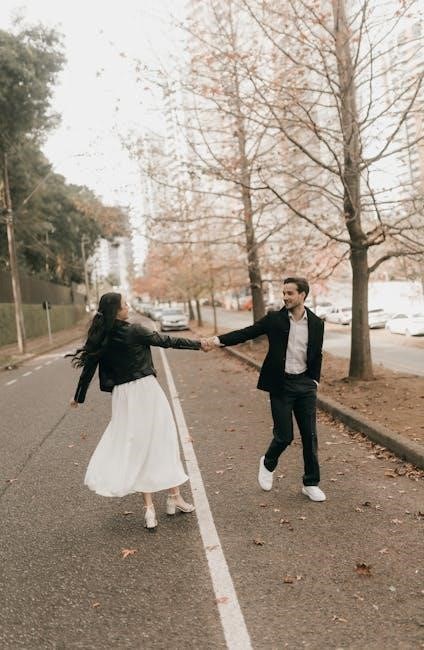Ozobot Color Codes are visual commands that guide Ozobot’s movements using color sequences. These codes‚ read by optical sensors‚ teach coding basics like cause-effect and critical thinking‚ suitable for young learners.
1.1 What Are Ozobot Color Codes?
Ozobot Color Codes are sequences of colors that instruct Ozobot on actions like speed‚ direction‚ and special moves. Using optical sensors‚ Ozobot reads these codes‚ enabling screen-free coding. They introduce coding concepts to young learners through visual commands‚ making programming interactive and accessible. These codes are essential for controlling Ozobot’s behavior‚ providing a creative way to explore robotics and programming principles.
1.2 Importance of Color Codes in Ozobot Programming
Ozobot Color Codes are fundamental in introducing coding concepts to young learners. They provide a screen-free‚ hands-on approach to programming‚ teaching critical thinking and problem-solving skills. By using color sequences‚ users can control Ozobot’s movements‚ making it an engaging tool for STEM education. The simplicity of Color Codes allows even pre-readers to grasp basic programming principles‚ fostering creativity and logical reasoning. This method bridges the gap between visual and textual coding‚ preparing students for more advanced programming languages in the future. The immediate feedback from Ozobot’s actions reinforces learning‚ making it an invaluable resource for educators and parents.

How Ozobot Color Codes Work
Ozobot Color Codes function through optical sensors detecting specific color sequences‚ triggering pre-programmed behaviors like speed changes‚ direction shifts‚ or special moves‚ enabling interactive programming experiences.
2.1 Optical Sensors and Color Detection
Ozobot’s optical sensors detect color sequences‚ enabling it to interpret commands. These sensors read colors through a camera-like system‚ translating them into specific actions. Calibration ensures sensors function optimally under varying light conditions. Proper color code placement on white paper enhances detection accuracy. Sensors may struggle with uneven surfaces or bright lighting‚ requiring adjustments for reliable performance. This technology allows Ozobot to follow visual instructions‚ making it an accessible tool for learning programming concepts. The sensor system is integral to Ozobot’s functionality‚ enabling it to respond to color-based commands effectively. Ensuring optimal sensor performance is key to successful Ozobot operation.
2.2 Pre-Programmed Behaviors Triggered by Color Codes
Ozobot’s pre-programmed behaviors are activated by specific color code sequences. These codes instruct the robot to perform actions like speeding up‚ slowing down‚ changing direction‚ or executing special moves. For example‚ a sequence of red and blue might signal a U-turn‚ while green and yellow could initiate a spin. These behaviors are built into Ozobot’s programming‚ allowing users to create complex paths and movements by arranging color codes in unique combinations. The robot’s ability to interpret and execute these commands makes it an engaging tool for teaching coding concepts. Calibration ensures accurate detection of these color sequences‚ enabling reliable behavior execution.
Types of Ozobot Color Codes
Ozobot Color Codes are categorized into Speed‚ Direction‚ and Special Moves. Each type triggers specific actions‚ enabling diverse programming options for users to explore creatively.
3.1 Speed Codes
Speed Codes are specific color sequences that control Ozobot’s movement velocity. These codes allow users to adjust the robot’s speed‚ ranging from slow to fast‚ even enabling turbo modes. By drawing these codes on paths‚ Ozobot’s optical sensors detect and execute the corresponding speed commands. Speed Codes are essential for precise control‚ enabling Ozobot to navigate complex routes smoothly. They are a fundamental part of Ozobot programming‚ teaching users how to manipulate movement dynamics. Mastering Speed Codes is crucial for creating intricate path designs and ensuring Ozobot operates efficiently in various educational and creative projects.
3.2 Direction Codes
Direction Codes are color sequences that instruct Ozobot to change its movement direction. These codes allow users to program turns‚ such as left‚ right‚ or U-turns‚ enabling Ozobot to navigate complex paths. By incorporating Direction Codes into their designs‚ users can create intricate routes and challenges. These codes are essential for teaching programming concepts like sequencing and control structures. They also enhance problem-solving skills as users experiment with different combinations to achieve desired outcomes. Direction Codes‚ combined with Speed Codes‚ provide a robust toolkit for controlling Ozobot’s movements‚ making them a core element in both educational and creative projects.
3.3 Special Moves and Cool Moves Codes
Special Moves and Cool Moves Codes are unique color sequences that trigger predefined‚ intricate actions in Ozobot. These codes go beyond basic movements‚ enabling actions like spinning‚ zigzagging‚ or performing a “Nitro Boost” for a speed surge. Cool Moves add creativity‚ allowing Ozobot to execute fun patterns or random turns. These codes inspire imaginative programming‚ teaching advanced sequencing and control structures. They also foster experimentation and problem-solving‚ as users discover how different color combinations yield varied results. By integrating Special Moves and Cool Moves‚ users can create dynamic‚ engaging paths that showcase Ozobot’s versatility and enhance STEM learning through interactive play.

Calibration of Ozobot for Color Codes

Calibration ensures Ozobot’s optical sensors accurately detect color codes. Proper adjustment to surface and light conditions is essential for reliable color recognition and precise robotic responses.
4.1 Why Calibration Is Necessary
Calibration is crucial for Ozobot to accurately detect color codes. Environmental factors like lighting and surface texture can affect sensor accuracy; Proper calibration ensures Ozobot reads colors correctly‚ enabling precise movements and behaviors. Without it‚ commands may be misinterpreted‚ leading to errors. Calibration adjusts sensors to specific conditions‚ ensuring reliable performance. This step is essential for consistent results in various settings‚ making it a cornerstone of effective Ozobot programming.
4.2 Step-by-Step Calibration Process
To calibrate Ozobot‚ start by placing it on a white surface and turning it on. Press and hold the power button for 3-5 seconds until the lights flash. This enters calibration mode. Allow Ozobot to adjust its sensors to the surface and lighting conditions. Once calibrated‚ you’ll hear a confirmation beep. Test the calibration by drawing a simple color code‚ such as a black line or a speed code‚ and observe Ozobot’s response. If it doesn’t react‚ repeat the process. Proper calibration ensures Ozobot accurately reads color codes and performs commands effectively. Recalibrate if lighting or surface conditions change.

Designing Ozobot Color Codes
Designing Ozobot Color Codes involves creating sequences of 2-4 colors using markers. Use white paper‚ thick lines‚ and avoid dark surfaces for optimal readability. Test codes to ensure accuracy and adjust as needed for consistent results. Properly designed codes ensure Ozobot performs desired actions smoothly.
5.1 Best Practices for Drawing Color Codes
When drawing Ozobot Color Codes‚ use thick‚ dark lines on white paper for optimal visibility. Ensure lines are 5mm thick and colors are vibrant. Avoid dark surfaces or patterns‚ as they can interfere with sensor readability. Use standard color combinations and keep designs simple. Test codes to confirm functionality and adjust if necessary. Properly drawn codes ensure accurate sensor detection and consistent Ozobot responses. Always refer to the Ozobot Color Code chart for guidance. This ensures your codes are effective and easy for the robot to interpret‚ leading to successful programming outcomes.
5.2 Creating Custom Color Code Combinations
Customizing Ozobot Color Codes allows for unique commands beyond pre-set options. Combine Speed‚ Direction‚ and Special Moves codes in new sequences to create complex behaviors. Experiment with 2-4 color sequences‚ ensuring each color transition is clear. Test each combination to verify functionality and refine as needed. Document custom codes for future use and share them with others. This encourages creativity and advanced problem-solving skills‚ making coding more engaging and personalized for users of all ages.
Applications of Ozobot Color Codes
Ozobot Color Codes are widely used in educational settings for teaching STEM and coding concepts. They also enable fun‚ interactive projects that foster creativity and problem-solving skills‚ making learning engaging and accessible for all ages.
6.1 Educational Uses in STEM and Coding Classes
Ozobot Color Codes are a powerful tool in STEM and coding education‚ teaching foundational concepts like sequencing‚ cause-effect‚ and debugging. They enable screen-free coding experiences‚ making complex ideas accessible to young learners. By using color commands‚ students can program Ozobot’s movements‚ fostering critical thinking and problem-solving skills. Educators integrate these codes into lesson plans‚ aligning with curriculum goals and promoting hands-on learning. Activities are designed to encourage creativity‚ teamwork‚ and innovation‚ preparing students for future tech challenges while making learning fun and engaging.
6.2 Fun Projects and Activities for Kids
Ozobot Color Codes offer endless fun for kids through creative projects. Children can design mazes‚ obstacle courses‚ and race tracks‚ using color commands to guide Ozobot. They can create storytelling scenarios where Ozobot interacts with characters or objects. Art projects‚ like drawing Ozobot’s path on paper‚ combine creativity with coding. Kids can also invent games‚ such as Ozobot tag or treasure hunts‚ using color codes to program movements. These activities spark imagination‚ teach sequencing‚ and provide hands-on learning. With simple tools like markers and paper‚ kids can enjoy hours of interactive play while mastering basic coding concepts in an engaging way.
Troubleshooting Ozobot Color Codes
Troubleshooting Ozobot Color Codes involves checking color accuracy‚ ensuring proper calibration‚ and verifying line thickness. Common issues include misreads due to faint colors or incorrect sensor alignment.
7.1 Common Issues and Solutions
Common issues with Ozobot Color Codes include faint or incorrect colors‚ improper calibration‚ and uneven line thickness. Solutions involve using vibrant markers‚ recalibrating sensors‚ and ensuring lines are 5mm thick. Additionally‚ outdated color codes or misaligned sensors can cause errors. Resetting Ozobot or updating its software often resolves these problems. Proper lighting and surface preparation are also crucial for accurate color detection. If Ozobot fails to respond‚ check for dust on sensors and ensure codes are drawn correctly. Regularly reviewing the Ozobot Color Code chart and following best practices can help minimize errors and improve functionality.
7.2 Debugging Tips for Color Code Errors
Debugging Ozobot color code errors involves testing individual codes to identify issues. Start by isolating each code and observing Ozobot’s response. Ensure codes are drawn clearly with vibrant colors and correct sequences. Check for calibration issues by recalibrating Ozobot on the same surface. Use the Ozobot Color Code chart to verify each code’s accuracy. Test on white paper only‚ as other colors can interfere. If errors persist‚ reset Ozobot or update its software. Regularly clean sensors to avoid dust interference. By methodically testing and adjusting codes‚ users can effectively troubleshoot and resolve errors‚ ensuring smooth Ozobot functionality and learning.

Resources for Ozobot Color Codes
Access downloadable PDF guides‚ manuals‚ and online tutorials for mastering Ozobot color codes. Webinars and community forums offer additional support for learning and troubleshooting effectively.
8.1 Downloadable PDF Guides and Manuals
Ozobot offers comprehensive PDF guides and manuals for color codes‚ providing detailed instructions on creating and using codes effectively. These resources include charts‚ examples‚ and step-by-step tutorials to help users master color code programming. The PDFs are designed for both educators and learners‚ ensuring easy understanding of concepts like speed‚ direction‚ and special moves. By downloading these materials‚ users can explore advanced techniques and troubleshoot common issues. The guides are regularly updated to reflect the latest Ozobot features and ensure optimal learning outcomes for all skill levels.
8.2 Online Tutorials and Webinars
Ozobot provides engaging online tutorials and webinars to help users master color codes. These resources offer step-by-step lessons‚ interactive examples‚ and live Q&A sessions. Webinars cover topics like map creation‚ line drawing‚ and advanced color code techniques. Recent sessions‚ such as the September 24‚ 2024‚ webinar‚ focus on fundamentals and troubleshooting. These online tools are ideal for educators and learners‚ offering flexible learning opportunities. By participating‚ users can gain practical skills and insights to enhance their Ozobot projects. Webinars are recorded and available on-demand‚ ensuring accessibility for all skill levels and learning styles.

Advanced Techniques with Ozobot Color Codes
Advanced techniques involve combining color codes with line following for intricate path designs. This allows for precise control over Ozobot’s movements‚ enabling complex patterns and behaviors easily.
9.1 Combining Color Codes with Line Following
Combining color codes with line following enhances Ozobot’s navigation. By integrating color commands into pathways‚ users can create complex routes where Ozobot changes speed or direction at specific points. This technique allows for precise control over movements‚ enabling the robot to adapt dynamically. For example‚ a blue line might guide Ozobot forward‚ while a red segment triggers a turn. This advanced method is ideal for intricate designs and challenges‚ fostering deeper learning in programming and problem-solving. It also encourages creativity‚ as users can experiment with various code-line combinations to achieve unique behaviors and patterns.
9.2 Using Color Codes for Complex Path Designs
Color codes can be strategically combined to create intricate and dynamic pathways for Ozobot. By layering speed‚ direction‚ and special move codes‚ users can design sophisticated routes with precise control. For example‚ a sequence of blue‚ red‚ and green codes can instruct Ozobot to speed up‚ turn sharply‚ and perform a spin. This approach is ideal for challenging students to think creatively about programming and problem-solving. Educators often use these complex designs in STEM activities‚ where students learn to visualize and execute multi-step commands. Such projects foster critical thinking and collaboration‚ making learning engaging and effective.
Real-World Examples and Case Studies
Students in a STEM class used Ozobot color codes to create a maze-solving robot‚ demonstrating how color commands can be applied to real-world problem-solving scenarios effectively.
10.1 Successful Projects Using Ozobot Color Codes
Successful projects using Ozobot color codes include maze navigation‚ art exhibitions‚ and STEM challenges. Students programmed Ozobots to solve intricate mazes using speed and direction codes. In art projects‚ Ozobots drew patterns on paper‚ showcasing creativity. Educators used color codes to teach coding concepts‚ enabling students to design complex paths and behaviors. These projects highlight how Ozobot color codes bridge technology and creativity‚ fostering problem-solving skills and innovation in educational settings. They demonstrate the practical application of color codes in real-world scenarios‚ making learning engaging and fun for students of all ages.
10.2 Inspiring Student Creations with Color Codes
Ozobot color codes empower students to create innovative projects‚ fostering creativity and problem-solving skills. Many students design intricate mazes‚ where Ozobots navigate using speed and direction codes. Others craft interactive stories‚ with Ozobots acting out scenes based on color commands. Art projects‚ such as drawing robots that create patterns‚ inspire self-expression. These creations often merge technology with art‚ teaching programming concepts in a fun‚ hands-on way. Educators report high engagement‚ as students collaborate on complex designs and debug their codes. Such projects not only build technical skills but also encourage imagination and teamwork‚ making learning dynamic and meaningful for young innovators.
Ozobot color codes are a powerful tool for teaching coding concepts‚ fostering creativity‚ and developing problem-solving skills. They inspire innovation and prepare students for future STEM challenges.
11.1 Summary of Key Points
Ozobot color codes are a versatile and engaging way to introduce coding concepts to learners of all ages. These color sequences‚ read by Ozobot’s optical sensors‚ enable users to control movements‚ directions‚ and special actions. By mastering color codes‚ users develop problem-solving skills‚ critical thinking‚ and creativity. The codes are simple enough for young students to understand yet versatile for advanced projects. Proper calibration and adherence to best practices ensure optimal performance. Ozobot color codes bridge the gap between physical and digital learning‚ making STEM education accessible and fun. They inspire innovation and prepare learners for future coding challenges.
11.2 Encouragement to Explore Ozobot Color Codes
Exploring Ozobot color codes opens a world of creative coding possibilities. These vibrant commands empower users to think innovatively and bring their ideas to life. Whether you’re a student or an educator‚ Ozobot’s color-based system makes coding accessible and fun. By experimenting with different color combinations‚ you can unlock new movements and behaviors‚ fostering problem-solving skills and creativity. Don’t hesitate to dive into the world of Ozobot color codes—start with simple sequences and gradually explore more complex designs. The joy of coding is just a color away‚ and the resources available‚ like downloadable PDF guides‚ will help you get started on this exciting journey!
Additional Resources
Explore Ozobot Color Codes with downloadable PDF guides‚ online tutorials‚ and community resources. These tools offer comprehensive learning and troubleshooting tips for mastering color code programming.
12.1 Links to Ozobot Color Code Tools and Communities
Access official Ozobot resources‚ including downloadable PDF guides and manuals. Explore online communities like the Ozobot Forum and STEM educators’ groups for tips and projects. Visit the Ozobot website for tutorials and webinars. Join social media groups to share creations and learn from others. Utilize tools like the Color Code Chart and Ozobot Classroom for structured lessons. These resources provide comprehensive support for mastering Ozobot Color Codes‚ from basic concepts to advanced techniques‚ ensuring a seamless learning experience for both educators and students.
12.2 Further Learning Opportunities
Expand your knowledge with Ozobot’s official webinars and downloadable resources. The Ozobot website offers detailed PDF guides and manuals to deepen your understanding. Explore educator-specific resources for structured lesson plans. Engage with the Ozobot community through forums and social media groups for shared projects and tips. Additionally‚ the Color Code Chart provides a visual reference for advanced techniques. Consider enrolling in Ozobot-hosted workshops or competitions to apply your skills in practical challenges. These opportunities ensure continuous learning and mastery of Ozobot Color Codes‚ making them ideal for both beginners and experienced users seeking to expand their capabilities.

